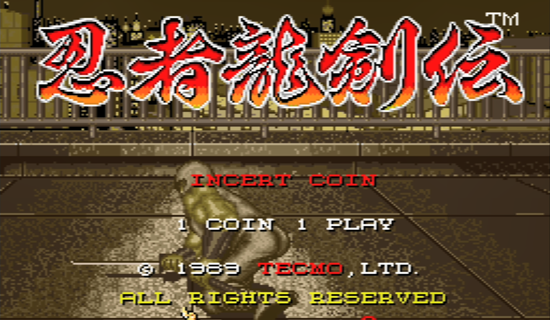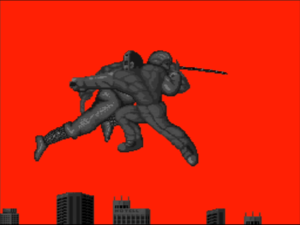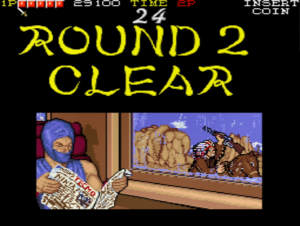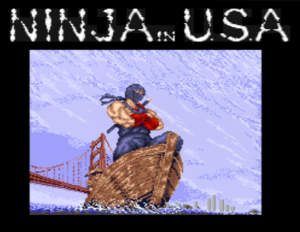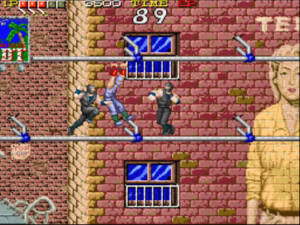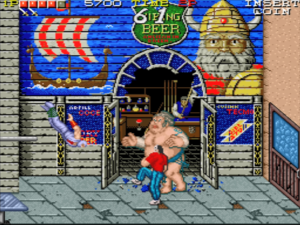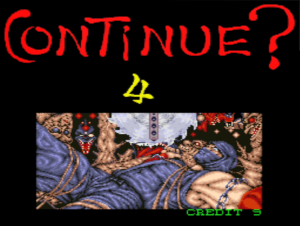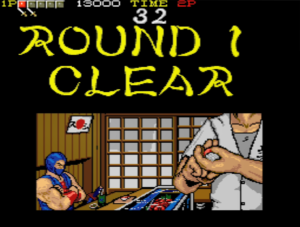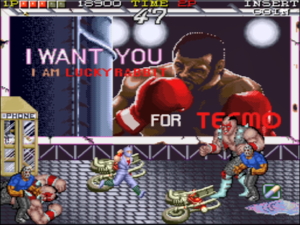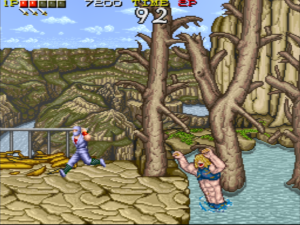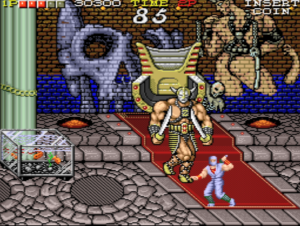Taking full advantage of America’s lingering ninja boom, the Ninja Gaiden arcade game was released four months earlier in the west than it was in Japan. This game is not to be confused with the much more well known NES/Famicom game by the same name though, and here’s where things get a bit confusing! According to this wonderful interview with Hideo Yoshizawa and Keiji Yamagishi by gaming.moe’s Heidi Kemps, the two titles were in production at the same time, and retained the same names to achieve name recognition (seemingly at the insistence of the company president). The arcade game hit America quite awhile before the NES game did, but didn’t hit Japan until after the Famicom version. Regardless, history has already determined which Ninja Gaiden people would end up caring about.
It’s a bit tired to compare the two, because they were created by two completely different teams within Tecmo, and are very different types of games. As Hideo Yoshizawa said in the previously mentioned gaming.moe interview, the reason the games felt so different was due to the difference in vision between the directors of each title. The director of the arcade game (Ijima, aka “Strong Shima” in the credits) liked belt-scroller style beat-em-ups, so that’s what the game ended up being. Both attempt to be cinematic in different ways throughout, but the arcade version doesn’t really succeed. It opens with a fight scene with two opponents running at each other (though not in a field, rather in a city in the rain), but it’s a bit more anti climatic here when we find out that our ninja’s opponent is just a regular hockey mask wearing nobody that are a dime a dozen throughout the game.
You do get an actual voice sample saying “Ninja Ryuukenden” (something added for the Japanese version of the game) after the scene is over though, which is also reused after every stage. There are also images that appear after completing each stage that may try to keep that same “cinematic feel” going, but they come off as being more comedic than anything else. I actually like them quite a bit!
And unlike the console version, there’s almost no story to speak of. Our lead ninja is not even named, so though he looks similar, this isn’t necessarily Ryu Hayabusa. Not to mention that since this is a two player simultaneous game, the second player takes the role of a nameless red-clad ninja. The only story to be found (which isn’t actually told in the game) is that in the year 1999, Bladedamus (a descendant of Nostradamus) has broken criminals out of Alcatraz, used them to form a crime syndicate, and kidnap the President of the US. Apparently our ninja comes all the way from Tokyo just to stop all of this, though I’m not sure why he would care.
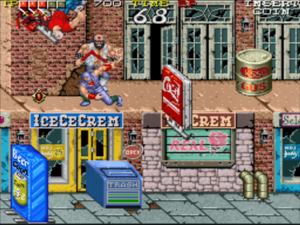
It does some unique things within the genre, that have everything to do with making the main character actually feel like a ninja. This is also where we have the most similarity to the console version. You can use your jump, along with a dedicated grab button, to grab onto overhangs or beams (in certain levels). From there you can throw out kicks to attack your enemies as they come to you. There’s also quite a bit of jumping up and dropping down onto a higher/lower level, very similar to what you find in Dragon Ninja/Bad Dudes. You can use your jumps to bounce off of objects in the levels and do back-flips as well.
The most important thing you can do with your jump though is to flip in one direction and hit attack as you pass over an enemy to throw them. It’s important to get the hang of how this works, since it should be your primary attack whenever you have more than a couple of enemies on screen. It’s relatively safe compared to just standing still and throwing out punches and kicks (which is what your standard attack button will do on its own). A sword power-up can also be collected to temporarily (it can be used 10 times before it disappears) make your regular attack much more useful and powerful, as well as making the back-flipping off of objects into an attack.
In terms of difficulty, it’s very similar to the Double Dragon arcade game in that it seems very challenging until you figure out the trick: There’s one move that’s way more effective than the rest. In Double Dragon it’s the elbow, but in Ninja Gaiden it’s definitely the flip-throw attack mentioned above. If you make good use of that on crowds, and adhere to the general beat-em-up rule that you should always approach an enemy diagonally instead of head on, you won’t have nearly as bad of a time with this game as you might think. There will come a point when the crowds of enemies get too big (as of stage 4), but that’s hardly something that only Ninja Gaiden is guilty of. In these cases even if your flip-throw won’t always work, because when too many enemies are clustered together it’s very likely that one will start hitting you as soon as you land from your jump, no matter how quickly you hit that jump button again. The game does start you from checkpoints after continuing though, and they seem to be pretty reasonably placed (save for making you go through the mini boss rush lead up again, if you die at the last boss).
Speaking of death, this game’s biggest legacy is probably the continue screen. No one who’s played it can ever forget the horrifying image of our ninja hero tied down with a giant buzz saw descending toward him, as he shakes his head furiously at his fate. And he’s surrounded by strange monsters while this is happening (they’re definitely not the masked prisoners that we’re used to fighting). Hideo Yoshizawa mentioned in his interview on gaming.moe that this was just a reflection of the director’s sensibilities.
As a beat-em-up, Ninja Gaiden is just sort of…fine. Tecmo’s attempts to do something original with the jumping and grabbing are appreciated, but ultimately it feels useless when the flip-throw is so key to getting through the game. Neither the enemies nor the bosses have very much flavor to them (though one set of them is obviously based on the Road Warriors), which is the same problem I had with Bad Dudes (Karnov excluded, of course). Though I really did enjoy the goofy between level images, there isn’t really much character to be had outside of those.
Though this is probably the easiest of the three, I’d put this below Bad Dudes and The Ninja Warriors as far as beat-em-ups that I’d want to go back and play. There’s nothing particularly wrong with any of these three games play, but Data East and Taito both injected more of themselves into the other two. And they subsequently became part of the culture surrounding those companies afterward. Tecmo really only ran with the console Ninja Gaiden games, and left this one behind. But maybe that’s because they realized they had put way more into one than the other.
For a long time there was no way to play this outside of the actual arcade game or emulation, but that was finally remedied in September 2005, with the release of Ninja Gaiden Black on the XBox. The arcade game was featured as an unlock-able bonus. In 2009 it was also released on the Nintendo Wii Virtual Console across all regions. Then much later in 2019, it was also released as a part of Hamster’s Arcade Archives series of downloadable titles on PlayStation 4 and Nintendo Switch (which feature both the Japanese and overseas versions, as well as the usual set of different modes found in all Arcade Archives releases).
All of these versions contained some fairly minor changes from the original arcade board: The boss music for stages 2 and 5 was dropped (the regular background music just keeps playing), supposedly due to similarities to Black Sabbath’s “Iron Man”. Uses of the Star of David on fairly unnoticeable things like carpets were also removed.
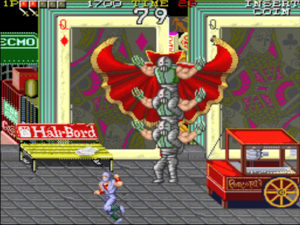
There were a few differences between the versions released overseas and in Japan as well: The previously mentioned voice sample that says the title of the game after each stage was only in the Japanese version. The music in stage 4 was changed in the Japanese version as well, apparently due to similarities to Bach’s Toccata and Fugue in D Minor. The most important difference though is that the Japanese version changes the damage that the regular enemies do in the final stage to a normal amount (one square of the player’s life bar for a single combo). In the previous versions, a regular enemy could kill you in just a couple of combos. This probably makes the Japanese version more preferable to play, at least in terms of difficulty.
Lastly, if you’re looking for direct ports of the arcade game, you’ve got plenty to choose from! The Atari Lynx port is the only notably good one, with the rest being (or at least looking) extremely bad: Amiga, DOS, Sinclair ZX81/Spectrum, Amstrad CPC, Atari ST, and Commodore 64. All of these releases save for the Lynx and DOS versions feature the title of “Shadow Warriors”, since they were all European developed.
